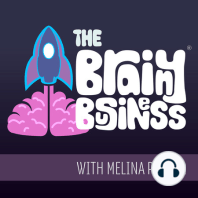33 min listen

36. Incentives - The "N" In NUDGES
FromThe Brainy Business | Understanding the Psychology of Why People Buy | Behavioral Economics
36. Incentives - The "N" In NUDGES
FromThe Brainy Business | Understanding the Psychology of Why People Buy | Behavioral Economics
ratings:
Length:
47 minutes
Released:
Feb 22, 2019
Format:
Podcast episode
Description
The word NUDGES is an acronym for the categories of nudging, and we are breaking those down episode by episode over the next six weeks to showcase different aspects of choice architecture and nudging. Today, we are starting with the N of nudges…which is for innnnnnncentives. This episode will explain what iNcentives mean when it comes to nudges, I will reference some excerpts from Nudge by Richard Thaler and Cass Sunstein, as well as some of their research papers. The goal of this behavioral economics podcast will be to help you think about how to offer incentives and nudge your clients to look at things differently while using nudges in your business. CLICK HERE FOR YOUR FREE DOWNLOAD! Show Notes [03:21] You are a choice architect if you present options to people and indirectly influence their choices – this is everything from where you place food in the line in the cafeteria to an opt in form on a website to doctors presenting treatment options. [04:23] A nudge is something that helps someone make a choice. This is everything from the order things are on a list of choices to the wording used to them, and yes, incentives. [04:51] Supply and demand fluctuate in predictable ways and are like two opposing forces in an intricate dance. [05:12] Proper incentives can help to encourage sales when you understand how they work. [05:14] The tricky thing about incentives is that they are never one sided and our lazy brains don’t tend to think about all the proper aspects of the choice presented. [05:51] Good choice architects understand how to structure the nudges and architecture to do what is best for their business. [06:02] Ask these questions to figure out what all the incentives are and how they work together: Who uses? Who chooses? Who pays? Who profits? [07:17] I am going to use the example of air conditioning as a constant throughout the series. [08:36] My husband and I bought a house that didn't have air conditioning installed. The builder gave us the option of adding air conditioning whenever we wanted. We decided to test out a Seattle summer and see if it was really needed. [09:08] After one super hot summer, we decided to get the air conditioning. [09:19] We had someone come to the house and do the evaluation for air conditioning. I learned the standard formula based on the square footage of the house, the number of vents, etc. [09:52] You think the choice is, “Do you want air conditioning or not?” Yes or no. Of course…it’s not really that simple, which is why this air conditioning example will be featured throughout the series. [10:28] For the air conditioning example, the person who uses is me/my husband. [10:57] Who chooses is my husband and I, but the choice is much more complex than meets the eye... [11:31] When cooling our home, we actually have many options such as using fans, staying in hotels, or filling our bathtubs with ice. There are also multiple companies to choose from once we decide we want air conditioning. [12:16] Who pays is my husband and I (note, payment is not always monetary). [12:45] The company that sells the air conditioning units (and their employee making the sale) are the ones who profit (as well as their manufacturers). There are different levels of profit. [13:57] I know there is markup on the items and I am paying for the convenience of not having to invent and build air conditioning. [14:42] What happens when there are conflicting incentives? [15:57] After we agreed to purchase the air conditioning, we were asked if we wanted a wifi enabled unit. [16:31] Wifi enabled allows you to adjust the temperature using your phone. [17:42] When finding this out my main question was, “Why would anyone NOT want this?” [17:55] It's also the same price as the unit without wifi. This got me thinking about what I would advise this company if they were a client of mine. [18:07] Why is it the same cost to the consumer? And why wasn’t that choice communicated better? Where was the nudge? [19:32] Do I want my
Released:
Feb 22, 2019
Format:
Podcast episode
Titles in the series (100)
14. Scarcity: Why We Think Less Available Means More Value: Fall is a favorite season of mine and probably a favorite season to many of you. It’s also the time of year that my favorite honeycrisp apples are available. Like cotton candy grapes, these apples benefit from scarcity. Today, I break down what... by The Brainy Business | Understanding the Psychology of Why People Buy | Behavioral Economics